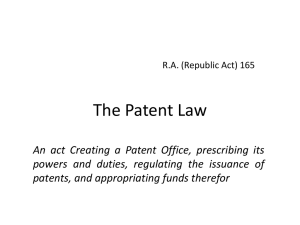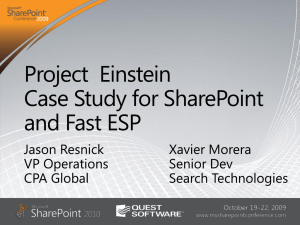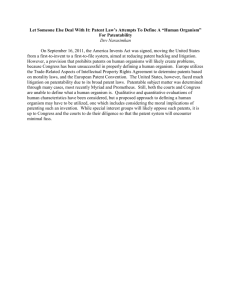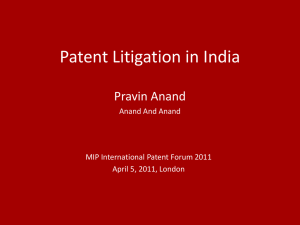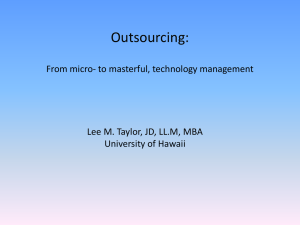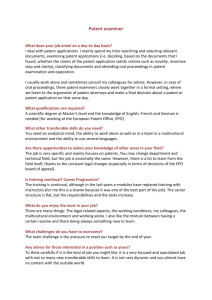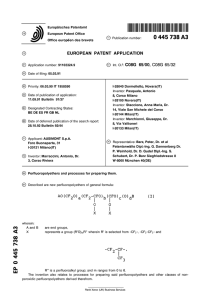NYCSR10A_403694
advertisement
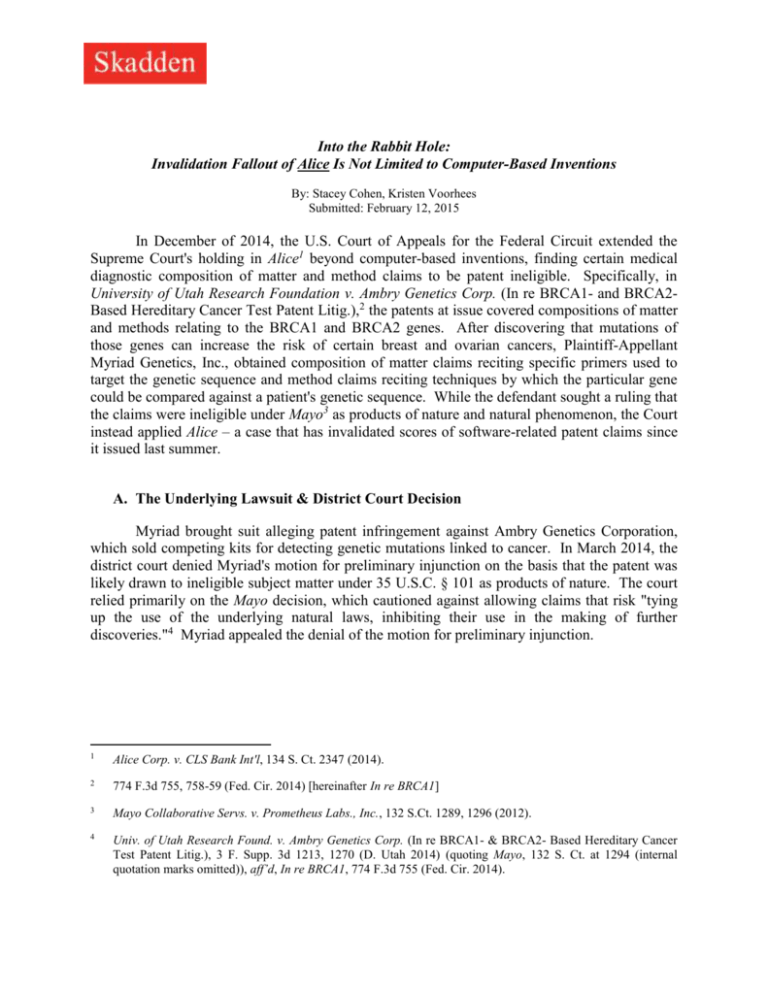
Into the Rabbit Hole: Invalidation Fallout of Alice Is Not Limited to Computer-Based Inventions By: Stacey Cohen, Kristen Voorhees Submitted: February 12, 2015 In December of 2014, the U.S. Court of Appeals for the Federal Circuit extended the Supreme Court's holding in Alice1 beyond computer-based inventions, finding certain medical diagnostic composition of matter and method claims to be patent ineligible. Specifically, in University of Utah Research Foundation v. Ambry Genetics Corp. (In re BRCA1- and BRCA2Based Hereditary Cancer Test Patent Litig.),2 the patents at issue covered compositions of matter and methods relating to the BRCA1 and BRCA2 genes. After discovering that mutations of those genes can increase the risk of certain breast and ovarian cancers, Plaintiff-Appellant Myriad Genetics, Inc., obtained composition of matter claims reciting specific primers used to target the genetic sequence and method claims reciting techniques by which the particular gene could be compared against a patient's genetic sequence. While the defendant sought a ruling that the claims were ineligible under Mayo3 as products of nature and natural phenomenon, the Court instead applied Alice – a case that has invalidated scores of software-related patent claims since it issued last summer. A. The Underlying Lawsuit & District Court Decision Myriad brought suit alleging patent infringement against Ambry Genetics Corporation, which sold competing kits for detecting genetic mutations linked to cancer. In March 2014, the district court denied Myriad's motion for preliminary injunction on the basis that the patent was likely drawn to ineligible subject matter under 35 U.S.C. § 101 as products of nature. The court relied primarily on the Mayo decision, which cautioned against allowing claims that risk "tying up the use of the underlying natural laws, inhibiting their use in the making of further discoveries."4 Myriad appealed the denial of the motion for preliminary injunction. 1 Alice Corp. v. CLS Bank Int'l, 134 S. Ct. 2347 (2014). 2 774 F.3d 755, 758-59 (Fed. Cir. 2014) [hereinafter In re BRCA1] 3 Mayo Collaborative Servs. v. Prometheus Labs., Inc., 132 S.Ct. 1289, 1296 (2012). 4 Univ. of Utah Research Found. v. Ambry Genetics Corp. (In re BRCA1- & BRCA2- Based Hereditary Cancer Test Patent Litig.), 3 F. Supp. 3d 1213, 1270 (D. Utah 2014) (quoting Mayo, 132 S. Ct. at 1294 (internal quotation marks omitted)), aff’d, In re BRCA1, 774 F.3d 755 (Fed. Cir. 2014). B. Federal Circuit Breaks Away From Party Arguments to Apply Alice On appeal, the Federal Circuit found that the composition of matter or "primer" claims were not distinguishable from isolated DNA because the primers "are structurally identical to the ends of DNA strands found in nature."5 Rather, "[a] DNA structure with a function similar to that found in nature can only be patent eligible as a composition of matter if it has a unique structure, different from anything found in nature."6 Because "[p]rimers do not have such a different structure," they are not patent eligible.7 With regard to the asserted method claims, the Federal Circuit also found these claims to be patent ineligible under § 101. Notwithstanding Ambry's assertions of invalidity under Mayo as ineligible recitations of natural laws or products of nature, the Federal Circuit found instead that both claims were invalid recitations of abstract ideas under Alice.8 1. Step One of Alice: Comparison Steps Were Directed to Ineligible Abstract Idea The claims at issue involve methods for "screening germline of a human subject" for an altered BRCA1 gene by "comparing" the wild-type sequence with the patient's sequence.9 One claim further required performing the comparison by "hybridizing a BRCA1 gene probe" and "detecting the presence of a hybridization product," while the other claim required performing the comparison by "amplifying all or part of a BRCA1 gene . . . using a set of primers" and "sequencing the amplified nucleic acids."10 In analyzing the claims, the Court first considered the "comparison step" of the asserted method claims, and found that this step was unpatentable because "it claimed an abstract mental process of 'comparing' and 'analyzing' two gene sequences."11 The court listed several reasons why it considered the claimed method to be an abstract process:12 1. "The number of covered comparisons is unlimited." 2. "The covered comparisons are not restricted by the purpose of the comparison . . . ." 5 In re BRCA1, 774 F.3d at 760. 6 Id. at 761. 7 Id. 8 Id. at 763. 9 Id. at 761. 10 Id. at 764, 761-62; U.S. Patent No. 5,753,441, col. 155, ll. 16-25, 57-63 (filed Jan. 5, 1996) (claim 7); U.S. Pat. No. 5,753,441, col. 155, ll. 16-25, 64-67 (claim 8). 11 In re BRCA1, 774 F.3d at 763; see also Ass’n for Molecular Pathology v. Myriad Genetics, Inc., 689 F.3d 1303, 1334-35 (Fed. Cir. 2012), aff'd in part, rev'd in part, 133 S. Ct. 2107 (2013) (finding claim 1 invalid). 12 Id.at 763-64. 2 3. "[T]he comparison step covers detection of yet-undiscovered alterations . . . ." 4. "[T]he comparisons are not limited to the detection of risk of breast or ovarian cancer." 5. "[A]llowing a patent on the comparison step could impede a great swath of research relating to the BRCA genes . . . ." 6. "[I]t is antithetical to the patent laws to allow these basic building blocks of scientific research to be monopolized." The court also briefly addressed the "pre-emption" issue13 of Alice, noting that "[t]he preemptive nature of the claims is not ameliorated even if we accept Myriad's argument that other methods of comparison exist. If the combination of certain routine steps were patent eligible, so too would different combinations of other routine steps."14 Although the court's reasoning begs the question of what it means to "preempt an idea" if the patent does, in fact, leave untouched other methods for performing the abstract idea, it may nonetheless foreclose future attempts to argue that the existence of non-infringing alternatives minimizes the risk of preemption and renders the claim patent eligible. 2. Step Two of Alice: Comparison Techniques Did Not Add Enough to Save Claims Moving on to step two of the analysis under Alice, the court found that the "particular mechanism for the comparisons" at issue did not "add 'enough' to make the claims as a whole patent-eligible."15 Specifically, the court held that "[n]othing is added by identifying the techniques to be used in making the comparison because those comparison techniques were the well-understood, routine, and conventional techniques that a scientist would have thought of when instructed to compare two gene sequences."16 Because the "second paragraphs recite only routine and conventional steps," the court held, "the claims, therefore, are directed to patentineligible subject matter." C. Practice Points For Patent Practitioners That the court in In re BRCA1 went out of its way to apply Alice rather than Mayo to invalidate the claims at issue is an indication that Section 101 analyses under Alice may play an 13 Before articulating the two-part test, Alice emphasized that "pre-emption" is the concern that "drives" the judicially-created exceptions to Section 101 patent-eligibility. Because "[l]aws of nature, natural phenomena, and abstract ideas are 'the basic tools of scientific and technological work', [m]onopolization of those tools through the grant of a patent might tend to impede innovation more than it would tend to promote it . . . ." Alice, 134 S. Ct. at 2354 (internal quotation marks omitted and citation omitted). The Court indicated that certain applications of the "building blocks of human ingenuity" may remain eligible for patent protection if they do not pose a disproportionate risk of "pre-emption." See id. at 2355. 14 In re BRCA1, 774 F.3d at 764 n.4. 15 Id. at 764. 16 Id. 3 increased role in litigations involving the pharma and biotech industries in the future. The ramifications of Alice have been significant: early reports indicate that motions seeking a determination of invalidity under Alice have experienced at least a 69% success rate in 2015.17 While the majority of those decisions concerned software, online business methods, and other computer-related patents, at least one series of cases involved patents for correlating the presence of certain genes with athletic performance.18 This, along with the court's decision in In re BRCA, suggests that the invalidating fallout of Alice will not necessarily be confined to business methods and software. However, the Federal Circuit's decision in In re BRCA also appears to give guidance as to how to avoid the rabbit hole of patent ineligibility under Alice. Specifically, the Federal Circuit noted differences between the method claims at issue and another claim in the patent, claim 21, which future litigants may be able to use to distinguish the case. The district court had suggested that claim 21 might be a patent-eligible application of Myriad's knowledge of the BRCA genes. The Federal Circuit, however, expressed no view on the patentability of claim 21, but noted that the claims at issue in In re BRCA were "significantly broader and more abstract, as they claim all comparisons between the patient's BRCA genes and the wild-type BRCA genes" while claim 21 was limited to methods of detecting only certain "expressly identified" alterations.19 This could be viewed as a guidepost for avoiding future determinations of patent ineligibility. 17 18 19 See, e.g., Patent Docket Report for February 5, 2015, DOCKET NAVIGATOR, Feb. 5, 2015, at 1 (on file with authors) ("The success rate of motions seeking a determination of invalidity for unpatentable subject matter has increased to 69% in 2015, up from 58% in 2014 and 25% in 2010."). See Genetic Techs. Ltd. v. Lab. Corp. of Am. Holdings, No. 12-1736-LPS-CJB, 2014 U.S. Dist. LEXIS 122780, at *3-4, *47 (D. Del. Sept. 3, 2014) (finding the only asserted claim ineligible under Section 101, which claimed "a method to predict potential sprinting, strength, or power performance in a human"); Genetic Techs. Ltd. v. Bristol-Myers Squibb Co., Nos. 12-394-LPS, 12-396-LPS, 2014 U.S. Dist. LEXIS 154443, at *43 (D. Del. Oct. 30, 2014) (holding one claim ineligible under Section 101, and requesting additional input from parties before determining validity of remaining claims); see also Genetic Techs. Ltd. v. Glaxosmithkline, LLC, No. 1:12-CV299, 2014 U.S. Dist. LEXIS 156473 (M.D.N.C. Aug. 22, 2014) (denying motion to dismiss under Section 101, but currently stayed pending appeal of final judgments in the related cases). In re BRCA1, 774 F.3d at 765. 4

